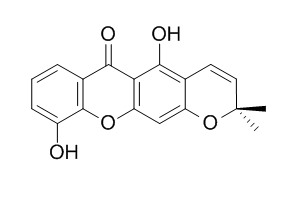6-Deoxyjacareubin
6-Deoxyjacareubin possesses significant antioxidant activities, it
also exhibits the cytotoxic activities against HL-60, SMMC-7721, A-549, MCF-7, and SW-480 cell lines.6-Deoxyjacareubin is antifungal against Cladosporium cucumerinum, while it shows differing degrees of inhibition of monoamine oxidase A and B. 6-Deoxyjacareubin shows strong platelet activating factor (PAF) receptor binding inhibitory effects using rabbit platelets with IC50 values of 29.0 microM, suggests that xanthones can represent a new class of natural PAF receptor antagonists.
Inquire / Order:
manager@chemfaces.com
Technical Inquiries:
service@chemfaces.com
Tel:
+86-27-84237783
Fax:
+86-27-84254680
Address:
1 Building, No. 83, CheCheng Rd., Wuhan Economic and Technological Development Zone, Wuhan, Hubei 430056, PRC
Providing storage is as stated on the product vial and the vial is kept tightly sealed, the product can be stored for up to
24 months(2-8C).
Wherever possible, you should prepare and use solutions on the same day. However, if you need to make up stock solutions in advance, we recommend that you store the solution as aliquots in tightly sealed vials at -20C. Generally, these will be useable for up to two weeks. Before use, and prior to opening the vial we recommend that you allow your product to equilibrate to room temperature for at least 1 hour.
Need more advice on solubility, usage and handling? Please email to: service@chemfaces.com
The packaging of the product may have turned upside down during transportation, resulting in the natural compounds adhering to the neck or cap of the vial. take the vial out of its packaging and gently shake to let the compounds fall to the bottom of the vial. for liquid products, centrifuge at 200-500 RPM to gather the liquid at the bottom of the vial. try to avoid loss or contamination during handling.
Front Pharmacol.2022, 13:972825.
JPC-Journal of Planar Chromatography 2017, 30(4)
Faculty of Chem. & Nat. Resource Eng.2014, 62
Plant Cell,Tissue & Organ Culture2016, 127(1):115-121
Molecules.2022, 27(22):7997.
Molecules.2023, 28(8):3474.
J Agric Food Chem.2024, 72(45):25219-25228.
J Ethnopharmacol.2022, 291:115159.
Food Funct.2023, 14(9):4354-4367.
J Agric Food Chem.2017, 65(13):2670-2676
Related and Featured Products
Pyranojacareubin
Catalog No: CFN89137
CAS No: 78343-62-1
Price: Inquiry(manager@chemfaces.com)
1,3,5-Trihydroxy-4-prenylxanthone
Catalog No: CFN98891
CAS No: 53377-61-0
Price: Inquiry(manager@chemfaces.com)
6-Deoxyisojacareubin
Catalog No: CFN89446
CAS No: 26486-92-0
Price: Inquiry(manager@chemfaces.com)
Ugaxanthone
Catalog No: CFN96469
CAS No: 13179-11-8
Price: Inquiry(manager@chemfaces.com)
Isojacareubin
Catalog No: CFN96573
CAS No: 50597-93-8
Price: Inquiry(manager@chemfaces.com)
1,3,6,8-tetrahydroxy-4-(3-methyl-2-buten-1-yl)-9H-Xanthen-9-one
Catalog No: CFN92541
CAS No: 1319198-98-5
Price: Inquiry(manager@chemfaces.com)
6-Deoxyjacareubin
Catalog No: CFN96276
CAS No: 16265-56-8
Price: Inquiry(manager@chemfaces.com)
1,3,7-Trihydroxy-2-prenylxanthone
Catalog No: CFN98022
CAS No: 20245-39-0
Price: Inquiry(manager@chemfaces.com)
1,7-Dihydroxy-3-methoxy-2-prenylxanthone
Catalog No: CFN97264
CAS No: 77741-58-3
Price: Inquiry(manager@chemfaces.com)
1,5,8-Trihydroxy-3-methoxy-2-prenylxanthone
Catalog No: CFN99202
CAS No: 110187-11-6
Price: Inquiry(manager@chemfaces.com)
J Ethnopharmacol. 2001 May;75(2-3):287-90.
Inhibitory effects of xanthones on platelet activating factor receptor binding in vitro.[Pubmed:
11297865]
METHODS AND RESULTS:
Nine naturally occurring xanthones were investigated for their platelet activating factor (PAF) receptor binding inhibitory effects using rabbit platelets. 2-(3-methylbut-2-enyl)-1,3,5-trihydoxyxanthone, macluraxanthone, 1,3,5-trihydroxy-6,6'-dimethylpyrano(2',3':6,7)-4-(1,1-dimethylprop-2-enyl)xanthone, 6-Deoxyjacareubin and 2-(3-methylbut-2-enyl)-1,3,5,6-terahydroxyxanthone showed strong inhibition with IC50 values of 4.8, 11.0, 21.0, 29.0 and 44.0 microM, respectively. The prenyl group at C-2, the dimethylprop-2-enyl group at C-4 and the hydroxyl group at C-5 are all beneficial to the binding of xanthones to the PAF receptor.
CONCLUSIONS:
The results revealed that xanthones can represent a new class of natural PAF receptor antagonists.
Molecules. 2011 Dec 7;16(12):10157-67.
Antioxidant phenolic compounds of cassava (Manihot esculenta) from Hainan[Pubmed:
22157579]
METHODS AND RESULTS:
An activity-directed fractionation and purification process was used to isolate antioxidant components from cassava stems produced in Hainan. The ethyl acetate and n-butanol fractions showed greater DPPH˙and ABTS·+ scavenging activities than other fractions. The ethyl acetate fraction was subjected to column chromatography, to yield ten phenolic compounds: Coniferaldehyde (1), isovanillin (2), 6-Deoxyjacareubin (3), scopoletin (4), syringaldehyde (5), pinoresinol (6), p-coumaric acid (7), ficusol (8), balanophonin (9) and ethamivan (10), which possess significant antioxidant activities. The relative order of DPPH· scavenging capacity for these compounds was ascorbic acid (reference) > 6 > 1 > 8 > 10 > 9 > 3 > 4 > 7 > 5 > 2, and that of ABTS·+ scavenging capacity was 5 > 7 > 1 > 10 > 4 > 6 > 8 > 2 > Trolox (reference compound) > 3 > 9.
CONCLUSIONS:
The results showed that these phenolic compounds contributed to the antioxidant activity of cassava.
Chinese Traditional & Herbal Drugs, 2016, 117(6):238-238.
Chemical constituents from fruiting bodies of Amauroderma rude[Reference:
WebLink]
To study the chemical constituents from the fruiting bodies in Amauroderma rude of family Ganodermataceae.
METHODS AND RESULTS:
The constituents were separated by column chromatography and their structures were elucidated by spectral data analyses. The cytotoxicities of compounds were evaluated using MTT methods. Twelve compounds were isolated and identified from the fruiting bodies of A. rude and were identified as diptoindonesin D(1), 6-Deoxyjacareubin(2), jacareubin(3), 1H-indole-3-carboxylic acid(4), methyl 3,4-dihydroxybenzoate(5), 3,4-dihydroxyphenylethanol(6), 3β-hydroxy-7,22E-dien-ergosta(7), 3β,7α-dihydroxy-8,22E-5α,6α-epoxyergosta(8), 3β-hydroxy-7α-methoxy-8(14),22E-dien-5α,6α-epoxyergosta(9), ergosterol 5α,8α-peroxide(10), 3β-5β-8β-trihydroxy-6,22E-ergosta(11), and 3β,5α-6β-trihydroxy-7,22E-dien-ergosta(12). Compounds 2 and 3 exhibited the cytotoxic activities against HL-60, SMMC-7721, A-549, MCF-7, and SW-480 cell lines and compound 9 showed the cytotoxic activities against HL-60, MCF-7, and SW-480 cell lines.
CONCLUSIONS:
All the compounds are obtained from this fungus for the first time. Compounds 2, 3, and 9 show the definite cytotoxicities against five cell lines.
Phytochemistry. 1994 Aug;36(6):1381-5.
An antifungal gamma-pyrone and xanthones with monoamine oxidase inhibitory activity from Hypericum brasiliense.[Pubmed:
7765428]
METHODS AND RESULTS:
A new gamma-pyrone (hyperbrasilone), three known xanthones (1,5-dihydroxyxanthone, 5-hydroxy-1-methoxyxanthone and 6-Deoxyjacareubin) and betulinic acid have been isolated from a dichloromethane extract of stems and roots of Hypericum brasiliense. Their structures were established by spectroscopic methods (UV, EI-MS, 1H and 13C NMR) and that of the gamma-pyrone was confirmed by X-ray crystallography.
CONCLUSIONS:
Hyperbrasilone and the xanthones were all antifungal against Cladosporium cucumerinum, while the three xanthones showed differing degrees of inhibition of monoamine oxidase A and B.



